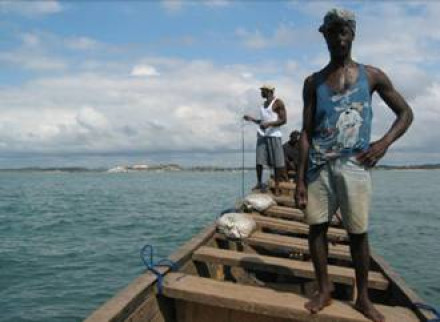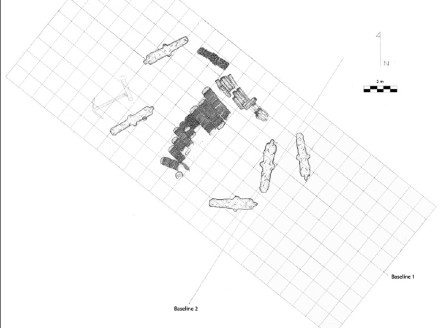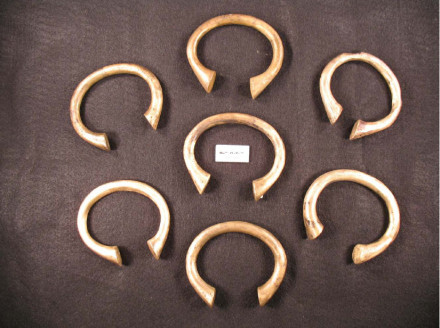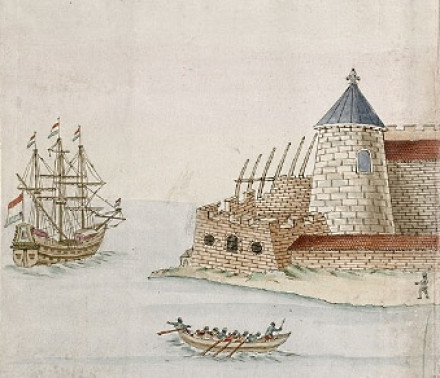History
Discovery
The 'Elmina wreck' was discovered during a 2003 side scan sonar survey by Greg Cook of Syracuse University, who named it after the nearby port town of Elmina, Ghana. Cook's initial reconnaissance of the site noted the presence of two large cannon, large rolls of sheet lead, stacks of brass basins and large clusters of brass manillas, suggesting that the sonar anomaly represented the remains of a European trade vessel. In 2007, a partial excavation of the site was carried out by the same institution, which uncovered some invaluable information on the vessel itself and more generally, on Euro-African trade interactions along the West African coast.

Research
The 2007 research project was primarily concerned with the vessel's cargo. Material such as various pewter- and brassware, lead rolls and beads offered a unique insight in the type of goods that were traded along the African coast. Adding to this, the overwhelming amount of manillas and cowry shells (bronze bracelets and a certain type of shell, often used to procure enslaved people), which were used as currency in Western Africa for many centuries, showed how European traders adapted to the indigenous economy. After conservation and analysis in the United States, all artefacts collected from the wreck site will be returned to the Ghana Museums and Monuments Board for museum curation and display.

More clues
Whatever may have been preserved of the ship's construction has remained hidden below a thick layer of concretion. In spite of that, the archaeologists were able to determine the ship's origin and dating through examination of the cargo and radiocarbon dating of the available timber fragments.
In that way, a mid-17th century (1642 -1664) Dutch origin of the ship was established. This fits with the historic time frame, since Elmina was at the center of the Dutch West African trade between 1637 and 1871. Until 1814, Elmina's castle served as a depot for enslaved people bought from African traders in exchange for European goods, such as those found on the Elmina wreck.

Identification
The only ship known to have been lost in the bay of Elmina during the mid-17th century was the Dutch West India Company merchant vessel Nieuw Groningen. An historical account mentions the ship's arrival at the Elmina roadstead on February 28, 1647. When a salute was fired, the cannon exploded, thus setting the ship on fire and causing it to sink. Numerous pieces of charred wood that turned up in sediment cores collected at the site testify of the dramatic event that took place over 360 years ago. All the combined clues lead to the theory that the Elmina wreck is indeed the Nieuw Groningen.
Significance
This wreck is of a very great historical value since it offers an insight into the day to day practice of slave trade. The castle of Elmina was a place where great amounts of enslaved Africans were kept prisoner in very bad circumstances, to be sold for transport to the Americas on ships like the Nieuw Groningen. From the beginning of the 17th century until about 1870, over 10 million Africans were transported and sold into slavery from forts like this one along the African coast. The Dutch Republic played a considerable role in this global trade, largely by means of its West India Company, to which the ship belonged. Goods from Europe such as weapons and steel and from farther away such as Asian textiles, manillas and cowry shells were shipped to this region to be traded for enslaved people. These were then taken to the Americas, where the ships would load goods from the plantations on which the Africans were forced to work (such as sugar and tobacco), to be taken back to Europe.

Description
Institutions involved: Syracuse University, Ghana Museums and Monuments Board, Cultural Heritage Agency of the Netherlands (RCE).

Status
In 2009 the wreck site was monitored by Syracuse University, and following the patterns observed between 2005 and 2009, it is assumed that the Elmina wreck site at this point is now completely covered with sediment. Therefore, despite the lack of legal protection of submerged archaeological sites in Ghana, the wreck site is considered as protected as it ever could be.
Another monitoring dive was planned for a 2013 survey campaign, sponsored by the Cultural Heritage Agency of the Netherlands (RCE). However, the project has been suspended following the sudden tragic death of its initiator, maritime archaeologist Rachel Horlings of Syracuse University. Undoubtedly, the wreck and Ghana's rich maritime history will continue to attract the interest of many archaeologists and historians.
References
- Gregory D. Cook, Rachel Horlings†, Andrew Pietruszka (2016).
Maritime Archaeology and the Early Atlantic Trade: research at Elmina, Ghana.
The International Journal of Nautical Archaeology, Vol. 45 issue 2.